History
With the outbreak of the First World War, the 78th Pictou Regiment (Highlanders) raised volunteers for the overseas battalions of the Canadian Expeditionary Force. During the Second World War, The Pictou Highlanders were active in a defensive role but were never engaged in battle. Details of the regiment were raised for local protective duty on September 1, 1939, and full mobilization occurred on January 1, 1941. The first move that the regiment made was to Newfoundland for coastal defense duty from March until August 1943. In September of the year, one company was dispatched to Nassau, Bahamas where it performed garrison duty until March 1946. A second company entitled Special Infantry Company (Pictou Highlanders) was mobilized on September 10, 1942, for service in the garrison of the Imperial fortress of Bermuda from November 12, 1942, to April 1, 1946. Their duties performed, both the active battalion and the Special Infantry Company were disbanded on April 30, 1946. During the life of the active units, a 2nd Battalion also served in Canada in the Reserve Army. [2]
In 1954, as a result of the Kennedy Report on the Reserve Army, this regiment was amalgamated with The North Nova Scotia Highlanders to form the 1st Battalion of The Nova Scotia Highlanders with The Cape Breton Highlanders forming the 2nd Battalion.
The Pictou Highlanders before amalgamation held its final Order of Precedence as 33. [3]
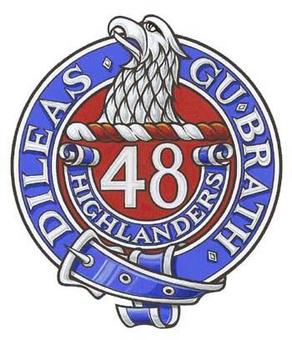
The 48th Highlanders of Canada is a Canadian Forces Primary Reserve infantry regiment based in Toronto, Ontario, parading out of Moss Park Armoury. The regiment is part of 4th Canadian Division's 32 Canadian Brigade Group.

The Nova Scotia Highlanders is an infantry regiment in the primary reserve of the Canadian Army. It is part of 36 Canadian Brigade Group, 5th Canadian Division.
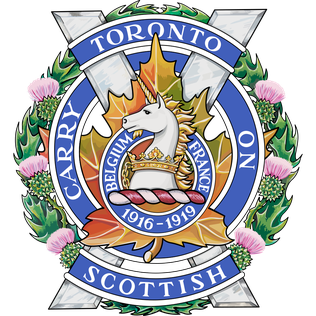
The Toronto Scottish Regiment (Queen Elizabeth The Queen Mother's Own) is a Primary Reserve infantry regiment of the Canadian Army based in Toronto, Ontario, Canada. The regiment was first formed in 1915 as the 75th (Mississauga) Battalion, CEF, and was later reorganized several times before being officially designated as The Toronto Scottish Regiment (Queen Elizabeth The Queen Mother's Own).
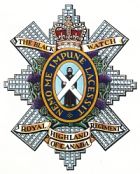
The Black Watch of Canada is a reserve infantry regiment in 34 Canadian Brigade Group, 2nd Canadian Division, of the Canadian Army. The regiment is located at 2067, rue Bleury in Montreal, Quebec, Canada, and is currently commanded by Lieutenant-Colonel R.M. Unger, MMM,CD. The regiment's armoury was designated a National Historic Site of Canada in 2008. They are the senior Canadian-Scottish Regiment.

The Prince Edward Island Regiment is a Primary Reserve armoured reconnaissance regiment of the Canadian Forces, 5th Canadian Division, 36 Canadian Brigade Group. The regiment is based in Charlottetown and Summerside, Prince Edward Island.

The Royal Highland Fusiliers of Canada is a Primary Reserve light infantry regiment of the Canadian Army, with companies in Cambridge and Kitchener, and is an infantry sub-unit of 31 Canadian Brigade Group, headquartered in London, Ontario. The Princess Margaret, Countess of Snowdon and The Prince Andrew, Duke of York, as members of the Canadian Royal Family, acted as Colonel-in-Chief.
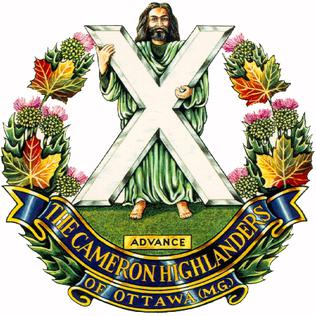
The Cameron Highlanders of Ottawa (Duke of Edinburgh's Own) is a Canadian Army Primary Reserve infantry regiment.
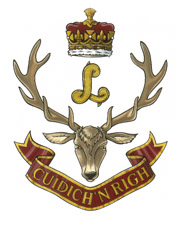
The Seaforth Highlanders of Canada is a Primary Reserve infantry regiment of the Canadian Army based in Vancouver, British Columbia. The regiment is subordinate to 39 Canadian Brigade Group, 3rd Canadian Division. Based at the Seaforth Armoury on Burrard Street in Vancouver, the regiment serves in both times of war and civil emergency, such as disaster relief after earthquakes or floods. It also contributes individual volunteers or "augmentees" to Canadian Forces operations around the world.
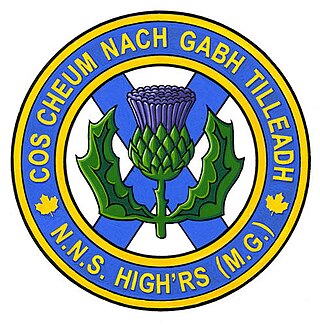
The North Nova Scotia Highlanders was an infantry regiment of the Canadian Army founded in 1936. In 1954, it was amalgamated with The Pictou Highlanders and 189 LAA RCA Battery to form 1st Battalion, The Nova Scotia Highlanders (North).

The Canadian Scottish Regiment (Princess Mary's) is a Primary Reserve infantry regiment of the Canadian Army based on Vancouver Island in British Columbia.

A Scottish regiment is any regiment that at some time in its history has or had a name that referred to Scotland or some part thereof, and adopted items of Scottish dress. These regiments were created after the Acts of Union in 1707 between England and Scotland, either directly serving Britain during its various wars, or as part of the military establishments of Commonwealth countries. Their "Scottishness" is no longer necessarily due to recruitment in Scotland nor any proportion of members of Scottish ancestry.

The 78th (Highlanders) Regiment of Foot was a Highland Infantry Regiment of the Line, raised in 1793. Under the Childers Reforms it amalgamated with 72nd Regiment, Duke of Albany's Own Highlanders to form the Seaforth Highlanders in 1881.

The Highland Light Infantry of Canada was an infantry regiment of the Canadian Army. In 1965, the regiment was amalgamated with The Scots Fusiliers of Canada to form The Highland Fusiliers of Canada.
The Prince Edward Island Highlanders was an infantry regiment of the Canadian Army. In 1946, the regiment was amalgamated with The Prince Edward Island Light Horse to form The Prince Edward Island Regiment (RCAC).

The Cape Breton Highlanders is an infantry regiment of the Canadian Army. It was established in 1871, merged into The Nova Scotia Highlanders in 1954, and re-established as a distinct regiment in 2011. It is part of the 5th Canadian Division's 36 Canadian Brigade Group and is headquartered at Sydney, Nova Scotia.

Canadian-Scottish regiments are regiments in the Canadian Army that maintain the traditions and style of dress used by Scottish regiments. Although these units maintain Scottish dress and traditions, recruitment for these units is open to all Canadians.
The Scots Fusiliers of Canada was an infantry regiment of the Non-Permanent Active Militia of the Canadian Militia. In 1965, the regiment was amalgamated with the Highland Light Infantry of Canada to form The Highland Fusiliers of Canada.
The Cumberland Highlanders was an infantry regiment of the Non-Permanent Active Militia of the Canadian Militia. In 1936, the regiment was amalgamated with The Colchester and Hants Regiment to form The North Nova Scotia Highlanders.
The Colchester and Hants Regiment was an infantry regiment of the Non-Permanent Active Militia of the Canadian Militia. In 1936, it was amalgamated with The Cumberland Highlanders to create The North Nova Scotia Highlanders.
The Argyll Light Infantry was an infantry regiment of the Non-Permanent Active Militia of the Canadian Militia. In 1936, the regiment was converted from infantry to form one of the Canadian Army's first tank units, and then in 1946 was converted to anti-tank artillery. In 1954, the regiment was converted back to infantry and amalgamated along with The Midland Regiment into The Hastings and Prince Edward Regiment.













